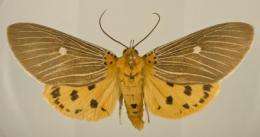Hidden habits and movements of insect pests revealed by DNA barcoding

University of Minnesota researcher George Weiblen and colleagues have found a faster way to study the spread and diet of insect pests.
Using a technique called DNA barcoding, which involves the identification of species from a short DNA sequence, Weiblen and an international team of researchers studied populations of numerous moth and butterfly species across Papua New Guinea. DNA barcodes showed that migratory patterns and caterpillar diets are very dynamic. In one case, a tiny moth that is distributed from Taiwan to Australia, has recently crossed thousands of miles of Pacific Ocean.
"DNA barcoding was developed for rapid identification but it also provides information about the habits and history of species," Weiblen says. He says this technique is of particular interest in Papua New Guinea, a country slightly larger in size than California with an insect diversity more than three times that of the United States. "New Guinea is one of those special places on Earth where we know very little about its biodiversity. This rich natural environment is increasingly threatened by economic development, and I'm concerned about how much biodiversity might be lost before we've had a chance to understand it. DNA barcoding helps to increase the pace of discovery."
Weiblen says that DNA barcoding can play an important role in studying the arrival of invasive species, such as the emerald ash borer, a species recently introduced from Asia. "We need to understand the genetic history of invasion in order to combat the pests that threaten trees and crops," Weiblen says. "DNA barcoding can pinpoint the geographic source of an invading species and measure the distances over which pest species can travel."
More information: The research, "Population genetics of ecological communities with DNA barcodes: An example from New Guinea Lepidoptera," was published in the Early Online edition of Proceedings of the National Academy of Sciences on March 1. To view the complete article, visit www.pnas.org/content/early/201 … 084107.full.pdf+html
Provided by University of Minnesota


















